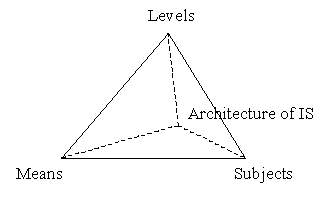
Abstract: The article introduces a model of the global information society (GISc). The model defines three levels of GISc, identifies types of subjects and their competencies. Finally an improved architecture of business information systems is discussed.
Key words: global information society, information system, Internet, 24x7 operation, architecture of IS
Information society – a term used so much last years – is not new long ago. Every society is – in a way – an information society. Every interaction inside the society (and with the surroundings) can be understood as an interchange of information. In other words, if at least two people meet, they influence each other and communicate (not only by voice). What, however, could be seen in the history of several years is rising importance of information. Informations tightly affect more and more processes running in the human society. In consequence, informations became commodity.
We can see easily the rise of importance of informations to be enabled by wide use of means of information and communication technology (ICT). The means permit to share the same information (even in the sense of time) all over the world. Nowadays, the society becomes really global.
Characteristics of the global information society can be summarized into the following items:
Disappearance of space limits – due to ICT and in view of access to an information, it is not important where the information is stored, and where the searching subject is located1. Costs associated with the access are not dependent on the extent2.
Disappearance of time limits – before we had to consider some delay of reactions to events. Nowadays, the delay is, owing to ICT, very often almost inconsiderable. Quick and multiplied reactions3 to events all over the world require, indeed, a change of management and planning approaches. Rapid reactions are usually welcome but we shouldn’t underestimate negative influence – e.g. distribution of an incorrect message. Disappearance of time limits bears on disappearance of space limits mentioned above. Our firm can be contacted by a customer from the other hemisphere out of usual working time. Hence, enterprises4 must operate 24 hours a day, seven days a week.
Disappearance of branches:
Today, enterprises must see a competitor not only in their own branch. A typical example is taking over of deposits by non-banking institutions (this continues to disintermediation, i.e. weakening of power of central banks).
Branches loos their strict definition – enterprises improve their products and services through ICT. ICT also enable co-operation of enterprises from different branches and so to create a new one. Companies must know which factors may affect their success – extension of products and services beyond branch boarder may reinforce them but it also causes augmentation of negative factors.
What was described here wouldn’t be possible if information was expressed with material. Such an information is distributed relatively slowly, occupies too space, is hardly modifiable, etc. Today, sharing information without ICT is almost unthought. ICT also improves market of informations. As was mentioned above, informations became commodity – first, information was strategic goods5, now it is consumer goods or object of other business. Everything what can be expressed electronically without loss of its primary quality (the case when the material expressing the information is just a medium) will finally be expressed electronically. Why? For it is easy and cheap to distribute. Consequently, enterprises must newly consider character of their product or service.
They, of course, should newly consider also their attitude to other subjects of the global market. It was already mentioned that subjects of the global information society have more opportunities and face up stronger competition. Nevertheless, competition is not the only way. The other possible form of co-existence is co-opetition (co-operation + competition), This means collaboration of subjects that would normally compete. The objective is synergic effect that leads to higher profit which is the final point of view of other objectives, such as decreasing costs (of production, investment…), reaching additional customers, and access to informations, especially about research and development.
Moreover, subjects must adapt themselves to requirements of others in case they are not so strong to define trends. Adaptation means – besides another changes – to change functionality of (information) systems This is true especially on business-to-business (B2B) markets. As for business-to-consumer (B2C), nothing has changed in fact. One should see it from the new point of view, however.
Following the foregoing text, it is possible to present a model of the global information society (GISc). This model offers a simple framework through which GISc can be defined. In the future another paradigm may appear. It will probably change the society. Unfortunately, I can only write something will happen. If I knew, what it is, I would write a different article.
Well, back to the model of GISc. The model is based on remote relationships, especially remote transactions6 between/among so far strange subjects, on positions of the subjects, and on possibilities to connect to others. Its parts are shown in the following figure fig. 1

FIG. 1 – MODEL OF GISC – OVERVIEW
First, the model is divided into three levels. Each of them has its mission and is in a certain relationship with the other levels (see fig. 2). Description of the levels follows:
Level of legal framework (LLF)
As in the usual life – it defines rules of moral minimum (law, conflict resolution etc.).
It defines metarules – rules for creating standards and other legal norms. We cannot expect that today’s standards and law will be sufficient forever. Actually, we can make an agreement on rules telling how to improve them.
The framework must be independent on technologies but must consider requirements of the society.
Level of integration and infrastructure services (LIIS)
In accordance with the legal framework, the services enable running GISc.
Level of producers and consumers (LPC)
In accordance with the legal framework, they use integration and infrastructure services to achieve their objectives (production and services, consumption, education, culture, entertainment etc.) more effectively/efficiently.
Every subject of this level can be a producer and a consumer (e.g. company producing some goods buys services of tax-advisors, universities offer education for what they need access to wide range of knowledge if they don’t create them…)
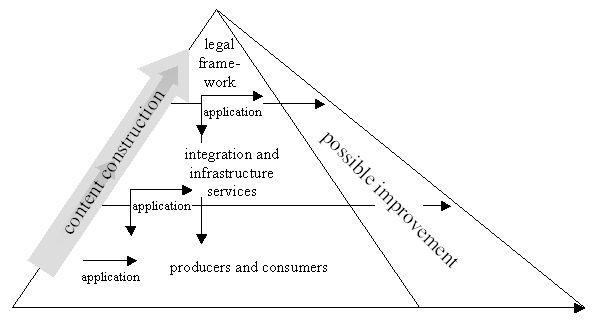
FIG. 2 – LEVELS OF GISC
Every level’s content should be built bottom-up while the application of the content should run top-down:
So, integration services are derived from needs of producers and consumers as subjects of LIIS automatically offer services for which their users are willing to pay. LLF is built according to needs of both lower levels because it is not possible to define rules without regard to subjects that are to respect them. And also, LLF is paid for this “service” by the subjects of the lower levels. It is then vital for LLF to create rules acceptable by the other levels.7 Finally, application of new products, services, regulations, etc. must be in coherence with the upper and the same level(s) – it must respect law and standards.
What is the difference between content construction and application? Application is an activity of subjects targeted to the same or lower level and is usually individual, as for initiator of the activity. Content construction is a reaction to demands for change of rules, form of service etc. that comes from a group representing a level or its part.
Another way how to describe GISc is to determine types of subjects. They are initiators of applications and/or content construction in GISc. Unfortunately, it is not possible to strictly classify the subjects over the levels. Subjects of GISc are approximately as follows:
Subjects rather of LLF:
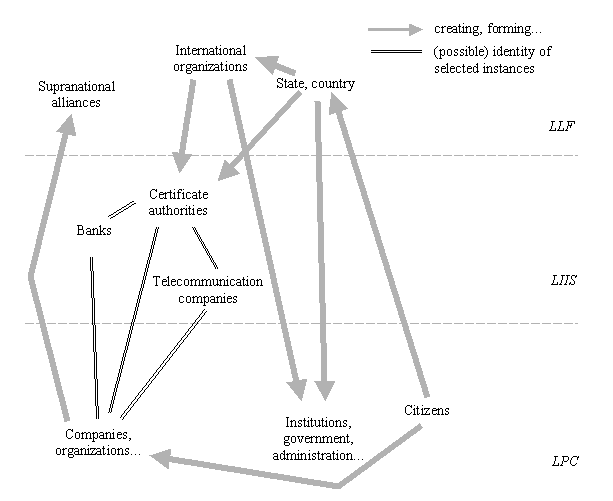
FIG. 3 – PERMEATION OF LEVELS IN GISC
Citizens elect their congressmen and senators and so they are a part of LLF. States form international organizations to assure common procedures and harmonization in different fields. Last two mentioned subjects use LIIS through their offices, commissions, and institutions. They also may act as certificate authorities.
Companies (based by citizens) build various (supranational) associations. These associations usually have objectives belonging to LLF. Some companies try to get to LIIS (e.g. payment services) while other belong to this level for their substantiality (banks, telecommunication companies including ISPs, certificate authorities).
(To be transparent, the figure doesn’t include relationship “citizens => state => commercial organizations”. Moreover, such relationships should be very rare.)
The means of GISc are ICT that enable us to perform remote transaction having the same (legal) meaning as “personal&paper” transactions. Of course, ICT are improving and so they may again influence the society’s character (as in last years). That is why a proper framework independent on technologies must be created. It also means to define standards assuring real global communication. To create such a framework, all subjects of all levels must co-operate.
Technologies of GISc must guarantee (see also fig. 4):
Flexibility of interconnection - To enable global communication, a technology allowing everybody to contact anyone else independently on other subjects and with minimal cost, and to communicate with him any quality we can perceive is needed.
Security
Communicated data must not be abused by third party. Hence, there should be possibility to keep it confidential, unmodified, and unique.
Every message should have defined its originator – we want to be sure who is the person we communicate with. Moreover, legal acts require non-repudiation of a message by its originator.
“Remote business” needs a procedure enabling business parties to agree on contracts. Such a procedure must assure both the parties to have the same document that cannot be changed without agreement of the other party of the contract.
For remote searching new partners it is necessary to know the informations supplied by them are true. A framework for quality certification authorities must be built.
Common language - Global flexible communication requires certain conventions and standards. Some common language must be constituted for all items mentioned above.
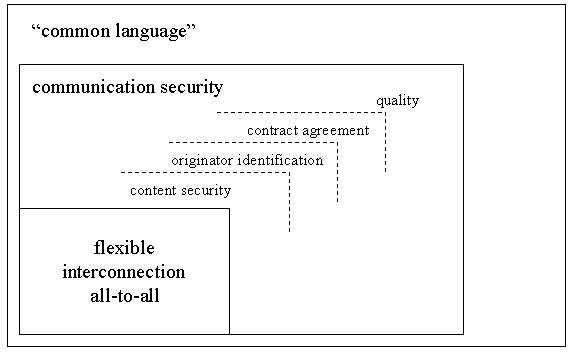
FIG. 4 – MEANS OF GISC
LLF must guarantee global usage of those technologies (and others that may appear) in consistence with good morals. What are good morals still remains a question (as for exact determination).
This part of the article is about changes of enterprise information systems concerning companies from both LIIS and LPC. How can the company be integrated with the environment? And why? The answer is easy – of course to survive and/or to be the best.
Companies must be:
reachable anytime,
able to communicate with the whole world (culture, language…),
ready for specific demands of customers and able to adapt themselves according to them – that also means:
This is valid (with some changes) for all companies offering a product/service – be it commercial unit or even government/state administration (it is a monopoly paid by citizens and companies).
It could seem active offering is forgotten. However, this approach can be improved using CRM applications to offer products to certain customers.
Back to the IS architecture. The praxis shows information systems based on ICT are a must. The architecture of enterprise information systems has to mirror the environment of GISc. Let’s go back to fig. 2.We can see IS must be consistent with law and standards. Then it can be connected to other subjects.
Connection to customers, suppliers, partners, banks, state administration etc. is realized via means of GISc (see fig. 4).
Global architecture of enterprise information systems can be easily displayed as follows (based on the architecture of IS published in [DOH97-1]):
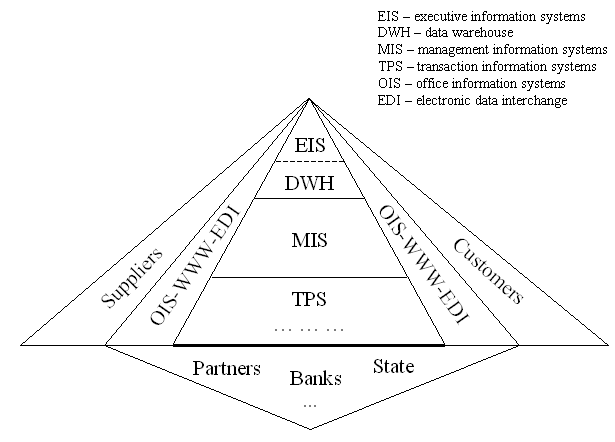
FIG. 5 – GLOBAL ARHICTECTURE OF ENTERPRISE IS IN GISC
The change to the previous model of the architecture is in joining EDI and OIS and in adding WWW subsystems. This shows the trend of WWW usage in front-end/customer applications enabling flexible remote access to IS. In fact, OIS-WWW-EDI corresponds in part with means of GISc. These are important for customers who become direct users of enterprise information systems. Similar situation is at the side of suppliers – here the enterprise becomes a user of IS of his suppliers, etc.
The architecture is improved also with another part containing:
business partnerss:
Among partial architectures, the process architecture becomes primary in GISc. It must enable companies to react properly to customers’ needs. It is necessary to project processes just to customers. Their requests then start processes in the enterprise system. This is why order management is the primary process running others, such as production etc.
Technological architecturechanges, as well. It must meet requirements of GISc according to its means (fig. 4). What can be described here is movement of application layer (if talking about client/server architecture) towards servers. At the side of customers, there stays just the user interface logic (what could be called Customer User Interface). However, a very different case is for example teleworking. Here the processing moves towards the user of the system. Generally, hard-client is more proper for detached work. It even may happen that both the sides change their roles (server <=> client). This way leads to outsourcing of employees or whole departments (see [BRU98-1]).
Nowadays, the world does not work according to the model globally. The model tries to offer a framework to better understand GISc and processes running in it with regard to future development. The development may be totally different and so other model will be needed. Now, I think, the society draws to a configuration that is expressed with the proposed model.
This article starts with a presentation of global information society’s (GISp) characteristics. After this preface, a model of GISp is proposed. The model consists of layers, subjects, means, and architecture of subjects. There are three layers in the model (see fig. 2): legal & working framework, integration & infrastructure services, and producers & consumers. The subjects are: international organisations (UNO, OECD, EU…), supranational organisations/associations/unions (ISF, EUROBIT, HLSG…), certification authorities, banking sector, telecommunications, companies, state administration/Civil Service/government administration, and citizens. Every subject belongs to a certain layer. However, we can see relationships between the layers (fig. 3). The means of GISp are flexible global interconnection, security (content and uniqueness of messages, sender identification + non‑repudiation of message, remote contract signing, guaranty of quality), and common language (standards, conventions etc.) – see fig. 4. Finally, an enhancement of enterprise information systems architecture with emphasis on wide co‑operation and interconnection with suppliers, customers, and partners is presented.
Sources:
|
[BRU98-1] |
Bruckner, T., Voříšek, J.: Outsourcing informačních systémů (Outsourcing of Information systems), EKOPRESS, Prague, 1998, in Czech |
|
[DOH97-1] |
Dohnal, J., Pour, J.: Architektury informačních systémů (Architectures of Information systems), EKOPRESS, Prague, 1997, in Czech |
|
Šlapák, O., Voříšek, J.: Integrace v globální informační společnosti (Integration in the Global Information Society) in Systems Integration Conference proceedings, Prague, 1999, in Czech |
1 We can abstract the difference between data and information here.
2 Charge for an information can be higher because of ownership of the information (e.g. research reports).
3 One can read about butterfly effect which metaphorically expresses today’s meaning of information spread: “The flapping of a single butterfly’s wing today produces a tiny change in the state of the atmosphere. Over a period of time, what the atmosphere actually does diverges from what it would have done. So, in a month's time, a tornado that would have devastated the Indonesian coast doesn't happen. Or maybe one that wasn't going to happen, does." (Ian Stewart, Does God Play Dice? The Mathematics of Chaos)
4 It needn’t be just a global enterprise – a customer on the road may need a service from his favourite (“local”) firm. Another customer may need a service for example at 11:55 p.m.
5 Who knows more has an advantage…
6 Transactions equivalent to transactions performed personally and with paper documents.
7 Fortunately, it happens in co-operation of subjects of all the levels.
8 Certificate authorities may assure not only identity but also quality of offered goods, verity of data, financial rating, etc.
9 It is possible to understand it as global information infrastructure.
10 Outsourcing – see [BRU98-1].